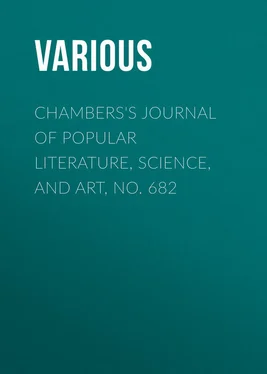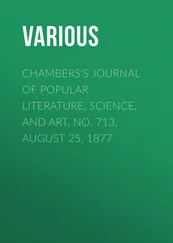Various - Chambers's Journal of Popular Literature, Science, and Art, No. 682
Здесь есть возможность читать онлайн «Various - Chambers's Journal of Popular Literature, Science, and Art, No. 682» — ознакомительный отрывок электронной книги совершенно бесплатно, а после прочтения отрывка купить полную версию. В некоторых случаях можно слушать аудио, скачать через торрент в формате fb2 и присутствует краткое содержание. Издательство: Иностранный паблик, Жанр: periodic, foreign_edu, на английском языке. Описание произведения, (предисловие) а так же отзывы посетителей доступны на портале библиотеки ЛибКат.
- Название:Chambers's Journal of Popular Literature, Science, and Art, No. 682
- Автор:
- Издательство:Иностранный паблик
- Жанр:
- Год:неизвестен
- ISBN:нет данных
- Рейтинг книги:4 / 5. Голосов: 1
-
Избранное:Добавить в избранное
- Отзывы:
-
Ваша оценка:
- 80
- 1
- 2
- 3
- 4
- 5
Chambers's Journal of Popular Literature, Science, and Art, No. 682: краткое содержание, описание и аннотация
Предлагаем к чтению аннотацию, описание, краткое содержание или предисловие (зависит от того, что написал сам автор книги «Chambers's Journal of Popular Literature, Science, and Art, No. 682»). Если вы не нашли необходимую информацию о книге — напишите в комментариях, мы постараемся отыскать её.
Chambers's Journal of Popular Literature, Science, and Art, No. 682 — читать онлайн ознакомительный отрывок
Ниже представлен текст книги, разбитый по страницам. Система сохранения места последней прочитанной страницы, позволяет с удобством читать онлайн бесплатно книгу «Chambers's Journal of Popular Literature, Science, and Art, No. 682», без необходимости каждый раз заново искать на чём Вы остановились. Поставьте закладку, и сможете в любой момент перейти на страницу, на которой закончили чтение.
Интервал:
Закладка:
Walking through the streets, what kind of aspect does Hygeia present? There is an absence of places for the sale of spirituous liquors. Whether by permissive bills or by temperance pledges, this kind of abstinence is so far enforced; and a drunkard would be forced out of the city by the frown of public opinion. Another moral restraint which, however, is one extremely difficult to impose – we will mention in Dr Richardson's own language, as it evidently expresses his opinion as a physician: 'As smoking and drinking go largely together – as the two practices were, indeed, original exchanges of social degradations between the civilised man and the savage (the savage getting very much the worst of the bargain) – so do the practices largely disappear together. Pipe and glass, cigar and sherry-cobbler, like the Siamese twins who could only live connected, have both died out in our model city. Tobacco, by far the most innocent partner of the firm, lived, as it perhaps deserved to do, a little the longest; but it passed away, and the tobacconist's counter, like the dram counter, has disappeared.'
The streets have plenty of life and movement in them, but a minimum of rattling jarring noises, owing to the heavy traffic being conducted through the underground railways. Most of the principal factories are at a short distance from the city; as are also large clusters of workrooms let out singly. A workman can have a workroom on payment of a moderate weekly rent; in it he can work as many hours as he pleases, but must not make it his home. Each block is under the charge of a superintendent, and under the supervision of a sanitary inspector. The artisan goes away from his home to work, like the lawyer, the merchant, or the banker. There might appear to be some waste of time in this arrangement; but it is more than compensated, in the opinion of the citizens of Hygeia, by comparative immunity from disease: 'It has,' says Dr Richardson, 'been found in our towns generally, that men and women who are engaged in industrial callings, such as tailoring, shoe-making, dressmaking, lace-making, and the like, work at their own homes among their children. That this is a common cause of disease is well understood. I have myself seen the half-made riding-habit that was ultimately to clothe some wealthy damsel rejoicing in her morning ride, act as the coverlet of a poor tailor's child stricken with malignant scarlet fever. These things must be, in the ordinary course of events under our present bad system. In the model system we have in our mind's eye, these dangers are met by the simple provision of workmen's offices or workrooms.'
Public laundries are a feature in Hygeia. If the washing of a small family is done at home, the housewife knows with what she has to deal; but when 'the washing is put out,' the linen of the family may, for aught she knows, have been mixed before, during, or after the process of washing with the linen from the bed or the body of some sufferer from a contagious malady. Some of the most fatal outbreaks of disease are known to have been communicated in this manner. To avoid these evils, public laundries are established in the outskirts of Hygeia, each with an extensive drying-ground, and all under sanitary inspection.
There is no one gigantic hospital, nor any hospital for special diseases – with perhaps one or two exceptions. Numerous small hospitals are distributed equidistant throughout the city; each constructed according to the most approved and efficient plan, and surrounded by its own open grounds. One of these would suffice for about five thousand inhabitants. The current system of large hospitals is abandoned, as being equivalent to 'warehousing diseases on the largest possible scale;' while special hospitals are deemed unnecessary – 'as if the different organs could walk out of the body and present themselves for separate treatment.' Each hospital has an ambulance ready to be sent out to bring any injured persons to the institution; the ambulance drives straight into the hospital, where a bed of the same height on silent wheels receives the patient, and conveys him or her to a ward. The staff is so appointed that every medical man in the city has in turn the advantage of hospital practice; whereby the best medical and surgical skill is fairly equalised through the whole community.
Homes for little children are abundant. In these the destitute young are carefully treated by intelligent nurses; so that mothers, following their daily callings, are enabled to leave their children under efficient care.
In a city so organised, it is believed that insanity would be very small in amount, and that a few small special establishments would suffice for its treatment. For the same reason huge buildings as workhouses for the destitute would be neither desirable nor necessary; small well-managed establishments, with useful work for all who are not really incapacitated, will be better both for the unfortunates themselves and for the ratepayers of the city. Ablution-baths, swimming-baths, play-grounds, gymnasia, public libraries, public schools, fine-art schools, and lecture-halls, are good and plentiful in Hygeia.
At a distance from the city are the water and gas works, and the sewage-pumping works. The water, drained from a river unpolluted by sewage, is filtered, and conveyed to the houses through iron (not lead) pipes. The sewage, brought from the city partly by its own flow and partly by pumping apparatus, is conveyed away to well-drained sewage-farms at a distance, where it is utilised as a fertiliser. Scavengers traverse the streets in early morning, and remove all refuse from roads, pavements, yards, and stables in covered vans to the sewage-farm. The public slaughter-houses, at some distance from the city, are under the control of inspectors, who examine all animals before being killed for food; and painless slaughtering, which is now known to be practicable, is adopted. The city cemetery is artificially made of fine carboniferous earth, on which vegetation springs up quickly. The dead, either in shrouds or in baskets or cradles of wicker-work, are placed in the earth, and vegetation soon covers them; and anything in the nature of a monumental slab or inscribed stone is placed in a spacious covered hall built for the purpose. The burial system is thus a compromise between the old graveyard usages to which England has been accustomed for a thousand years or more, and the very un-English process of cremation which has a few advocates among us.
Such is Hygeia, the imaginary City of Health. Dr Richardson states his reasons for thinking that mortality would lessen to eight per thousand per annum in the first generation, in a community thus domiciled and organised; and afterwards lessen to five per thousand. He says, to the audience he addressed: 'Do not, I pray you, wake up as from a mere dream. The details of the city exist; they have been worked out by the pioneers of sanitary science; I am but as a draughtsman who has drawn out a plan, which you in your wisdom can modify, improve, perfect.' Whether by speculative landowners, architects, and builders, or by social reformers who have no interested or professional motives, a scheme has been brought forward for a City of Health to be called Hygeopolis , somewhere on the Sussex coast; but it is only in the rough, without any detail of 'ways and means.' We fear that the whole project is little better than a dream. It is certain that a city such as Dr Richardson portrays in imagination could not be established without a revolution in our social habits; that a species of communism would supplant a good deal of individual enterprise; and that the local rates, however imposed and however collected, would be enormously heavy. Nevertheless, many of the suggestions are admirable, and could be singly worked out in most of our existing towns.
THE LAST OF THE HADDONS
Интервал:
Закладка:
Похожие книги на «Chambers's Journal of Popular Literature, Science, and Art, No. 682»
Представляем Вашему вниманию похожие книги на «Chambers's Journal of Popular Literature, Science, and Art, No. 682» списком для выбора. Мы отобрали схожую по названию и смыслу литературу в надежде предоставить читателям больше вариантов отыскать новые, интересные, ещё непрочитанные произведения.
Обсуждение, отзывы о книге «Chambers's Journal of Popular Literature, Science, and Art, No. 682» и просто собственные мнения читателей. Оставьте ваши комментарии, напишите, что Вы думаете о произведении, его смысле или главных героях. Укажите что конкретно понравилось, а что нет, и почему Вы так считаете.







